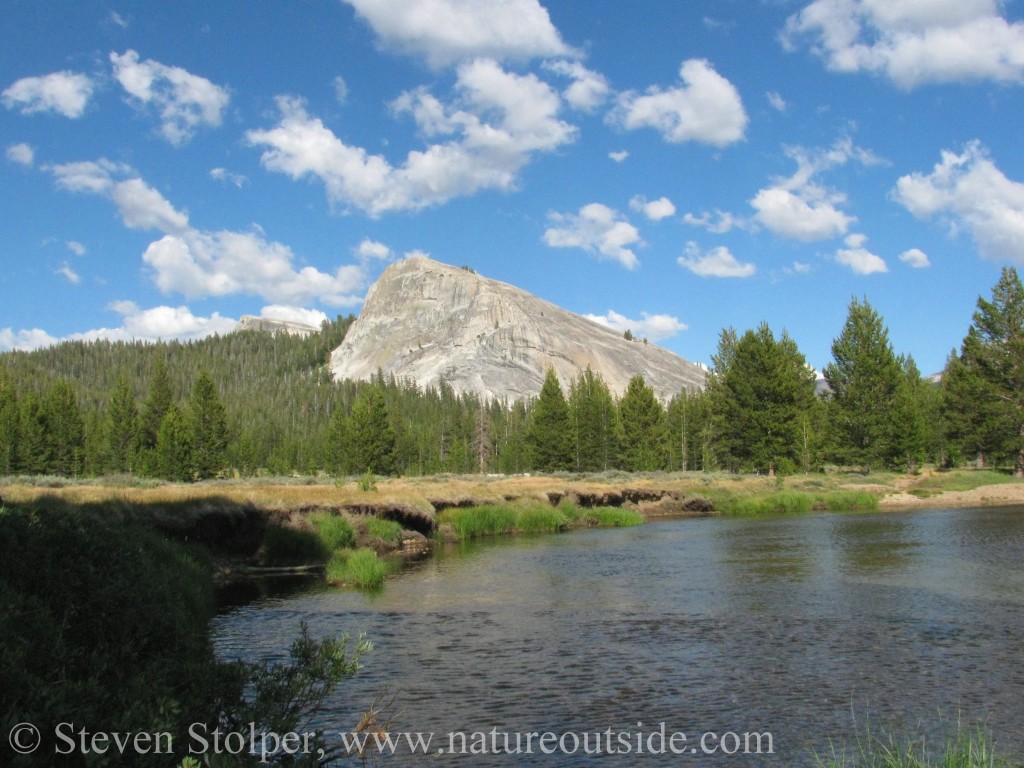
Lembert Dome
This post is part of a series about my hike on Yosemite’s High Sierra Loop.
When you embark on an adventure, any adventure, you feel more alive. Your senses sharpen, your heart pounds, your spirits soar. Adventure is not an object you can grasp or a tangible quality. Nobody says, “Can you hand me some adventure?” or “That fishing pole has a lot of adventure in it.” Adventure is that ethereal feeling that comes with novelty, challenge, and growth. English Author George Eliot (whose real name was Mary Ann Evans) forthrightly observed, “Adventure is not outside man; it is within.”
So when I caught my first glimpse of Tuolumne Meadows beyond the car windshield, I exulted. Four hours earlier I had pulled out of my driveway. I left at dawn hoping to escape the morning traffic – Ha! Those hopes were dashed in short order. But putting 7 million people in my rearview mirror quickly buoyed my spirits. Suburbs gave way to small agricultural towns. Seemingly endless walnut orchards gave way to rangeland. The rolling foothills transformed into mountains. Finally the road signs began their breathless chant, “Elevation 4000 feet”, “Elevation 5000 feet”, “Elevation 6000 feet.” My car felt like an airplane as it climbed Tioga Pass Road to the meadows at 8,600 feet.
Attitude and Altitude
I arrived at Tuolumne Meadows in the early afternoon the day before the hike. My plan was to give myself a day to acclimate to the altitude. I have always done well with altitude. But hiking at high elevation is like investing, “past performance does not guarantee future returns.”
With the advent of the automobile, you can literally wake up at sea level and be at 8,000’ before lunch. When I climbed Mount Whitney (14,395’), I saw hikers attempting to summit in one day. Some had driven up from sea level communities near Los Angeles the night before. The result was not pretty. Many achieved their goal but suffered the entire way. For others, the consequences were dire. On that trip my hiking partner and I assisted a woman suffering the early stages of pulmonary edema.
Like any other potential risk factor, I take the effects of altitude seriously. However, my arrival day was more about comfort. I could laze about the meadow and spend a restful evening helping my body acclimatize. When I hit the trail in the morning, I was much more likely to be ready for an 8 mile hike with pack.
This is consistent with a key tenet of bushcraft: If you are “roughing it” you are doing it wrong. Instead, I try to “smooth” my wilderness experience. By arriving early to acclimatize, I increased the chances I would enjoy my wilderness trip. I could behold the scenery every time we stop instead of doubling over, panting, to inspect the tops of my boots. 🙂
Walking the Tuolumne
After checking into my tent-cabin at Tuolumne Lodge, I grabbed my camera and a water bottle for a stroll through the meadow. I chose to follow the banks of the Tuolumne River that flows through it.
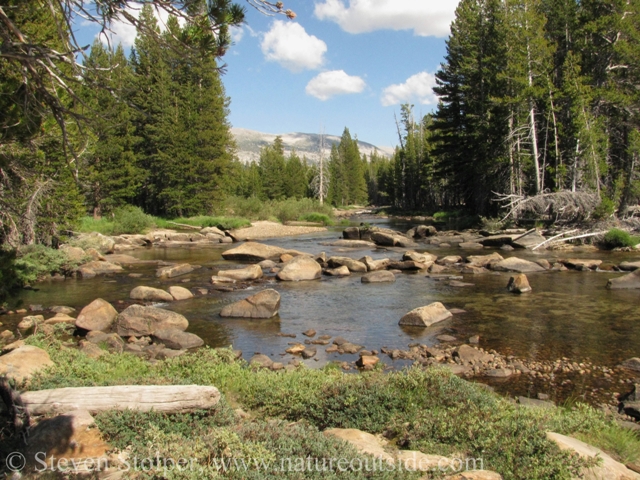
Looking upstream on the Tuolumne River
The water was crystal clear and very cold. I could make out brook trout and brown trout below the surface, facing upstream in the expectation of bounty brought by the current. In the near distance is Lembert Dome (9,450’), a sweeping polished granite mound. Its promise of a panoramic view of the meadow entreats the hiker to climb its curving slopes (see picture at top of post).
Marmota flaviventris
During my hike downstream, I noticed movement among the lodgepole pines and in the nearby grasses. My first thought was “ground squirrel”, but the patterns of noises didn’t sound quite right. As I continued my hike I would see flashes of fur as small creatures scurried out of view at my approach. They could be squirrels, but the shape and size did not seem to fit.
I settled along the river bank, under the shade of a cluster of pines. After a few minutes, a creature revealed itself. A yellow bellied marmot! I see so few of them – that’s why it took me so long to puzzle it out. I inched closer to take these pictures:
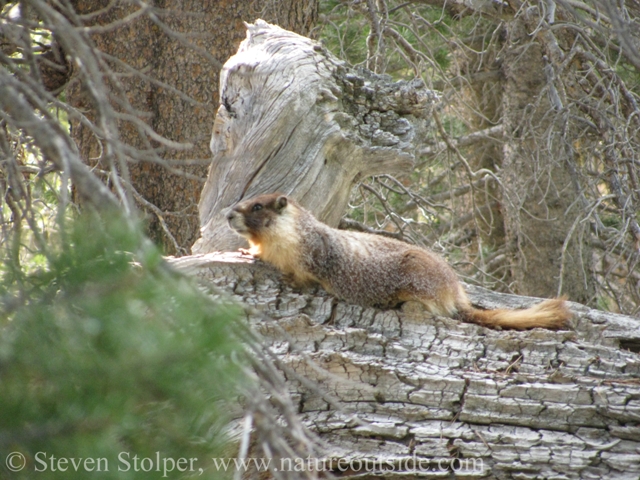
Yellow Bellied Marmot (Marmota flaviventris)
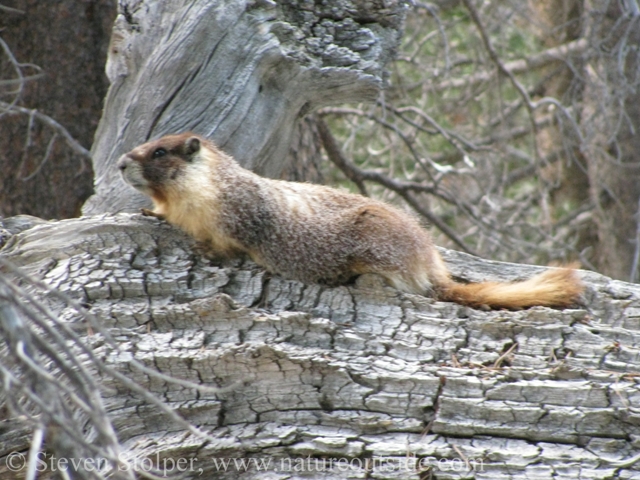
Marmots like to bask on rocks or trees like furry throw rugs
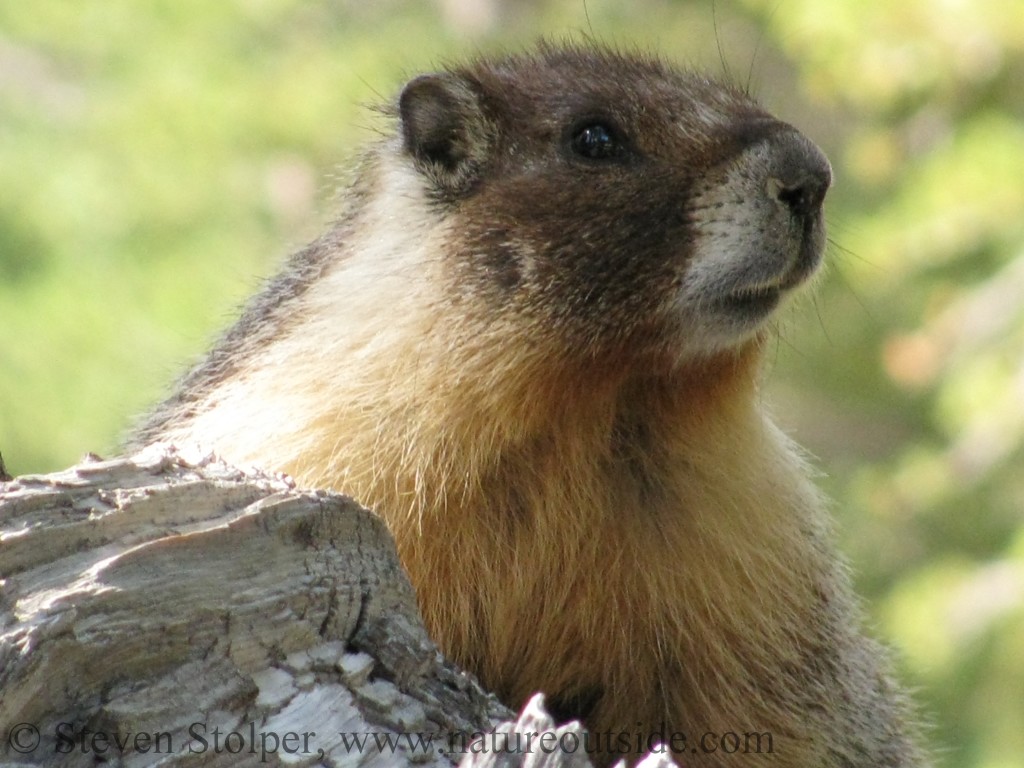
Yellow Bellied Marmot on the lookout for predators, mates, and other males
Marmots are found in California above 6,000’. They are known to sunbathe in the afternoons perched on rocks and trees. Elbroch and Rinehart say they “splay out like throw rugs”, which is an apt description.
This creature’s body was more than 20” long with a 6” tail. In mid-summer, a marmot like this one spends its time foraging close to its den for grasses and forbs. They are semi-fossorial. Their limbs are adapted to excavate the burrows in which they live. I was delighted that it showed no sign of being tame. Yosemite sees its fair share of tourists who can’t resist trying to feed the cute animals.
Always Filter your Water
I turned back along the Tuolumne River to return to the lodge. Hiking upstream, I passed a couple of teenagers wading into the cold water seeking relief from the hot afternoon. As I turned the next bend in the stream, there was a black-tailed deer standing in the river peeing and defecating directly upstream of the young people splashing around the bend. It was a reminder that no matter how clear and cold the river, I should always filter, treat, or boil my water! 🙂
Campfire
 James, our ranger-guide, assembled the group after dinner at a fire ring in the woods beyond the lodge’s tent cabins. There were 11 of us and the ranger guide. Most were middle-aged men who were old buddies from medical school back east. They turned out to be a very interesting bunch. All of them were immensely likable and had a jovial rapport with one another.
James, our ranger-guide, assembled the group after dinner at a fire ring in the woods beyond the lodge’s tent cabins. There were 11 of us and the ranger guide. Most were middle-aged men who were old buddies from medical school back east. They turned out to be a very interesting bunch. All of them were immensely likable and had a jovial rapport with one another.
On any group trip, your fellow travelers always color your experience. While you are solely responsible for your own happiness, the tenor of the group subtly influences how you perceive your journey. You can always elect to isolate yourself from a group you think is unpleasant. But the antisocial nature of such a course is self-defeating. You end up feeling alone among strangers and it ruins your trip. So I was very happy with the way our group was shaping up.
Ranger James is an interesting guy. He has been leading trips in Yosemite for many years. An experienced back country traveler, he regaled us with stories by way of introduction. In addition to his work as a seasonal ranger, he is an artist (a plein air painter), and an avid fly fisherman. Earlier in the evening I had dinner at the lodge’s communal tables. When the people seated next to me learned I would be hiking the loop, they gushed, “I hope you get Fishkiller as your guide. He is terrific!” I was happy to learn that Fishkiller would indeed be our guide.
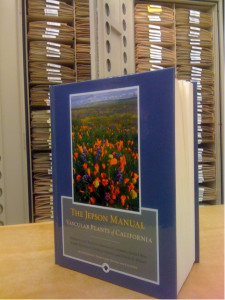
Current version of The Jepson Manual. Image courtesy of the University and Jepson Herbaria, University of California, Berkeley
Ranger James came across as a bit of a character that evening. He asked who among us had room to carry some of his field guides in their packs. As I’ll discuss in the next installment, I packed a little differently than my fellow travelers. While they all carried full packs, I was going to carry a Kelty Redwing. It is a day/weekend pack smaller than a traditional backpack. So space was a premium for me. But after he finished passing out the books, he announced that one more book still remained. Resigned, I stepped forward and raised my hand. I would fit the book somehow. To my utter astonishment he pulls out The Jepson manual: vascular plants of California! If you are unfamiliar with this book, it is the single most comprehensive resource on California’s flora. It is also, according to an online retailer, 10.9 x 8.4 x 2.4 inches weighing 5.8 pounds!!! 😯
As I recovered from my shock I heard the laughter. I had taken the bait hook, line, and sinker. Fishkiller strikes again! (I should mention that I was in such a state of shock that I am uncertain to this day that it was actually a Jepson manual. But it was a huge book!)
An Unexpected Friend
After the group broke up, I headed to the outdoor spigot to fill my water bottles before bed. I timed it just right because the person using the spigot finished as I arrived. When he turned around, I let out a delighted yelp! It was my old boss from almost 15 years ago! It was wonderful to see my dear friend and his family. They were headed out in the morning on a 3-day mule trip. The joyous reunion was a good omen for my journey.
Next Post: Tuolumne Meadows to Glen Aulin
The High Sierra Loop – Indroduction
Day 1: The High Sierra Loop – Tuolumne Meadows to Glen Aulin
Day 2: The High Sierra Loop – Glen Aulin to May Lake
Day 3: The High Sierra Loop – May Lake to Sunrise Camp
Day 4-5: The High Sierra Loop – Sunrise Camp to Merced Lake
Day 6-7: The High Sierra Loop – Merced Lake to Vogelsang
References
Mammals of California, E.w. Jameson, JR., and Hans J. Peters, University of California Press, 2004
Behavior of North American Mammals, Mark Elbroch and Kurt Rinehart, Houghton Mifflin Harcourt, 2011
The Jepson manual: vascular plants of California, second edition, Baldwin, B. G., D. H. Goldman, D. J. Keil, R. Patterson, T. J. Rosatti, and D. H. Wilken, editors, University of California Press, 2012



Leave a Comment